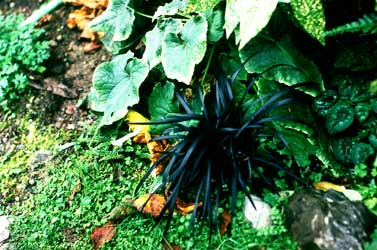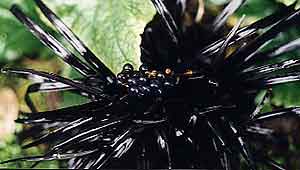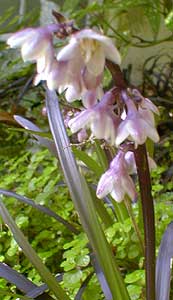 Black Mondo Grass
Black Mondo Grass
"In the old age black was not counted fair
Or if it were, it bore not beauty's name;
But now is black beauty's successive heir,
And beauty slander'd with a bastard's shame."
-William Shakespeare
(1564-1616)
(1564-1616)
Black Mondo grass Ophiopogon planiscapus 'Nigrescens') when still a new cultivar was occasionally sold as 'Arabicus,' 'Ebony Knight,' or by the silly names 'Black Monkey Grass' or 'Black Dragon,' but the name that eventually suck was the elegantly simple Black Mondo Grass.
In the first photo can see planted above the black grass the first-year leaves of a money-plant which will be more variegated in the second year. To the right you can see part of a spreading Persian Violet Cyclamen. The tiny ground cover is Baby's Tears; it has crept into the garden on its own, having been intentionally planted only between the cracks of nearby flagstones.
 The original evergreen lily-grass native of Japan & Korea was a normal color of green. The black variety developed in England sometimes has a purplish tinge, but is probably just about the nearest to a "true black" plant that has yet made it onto the Gothic Garden scene.
The original evergreen lily-grass native of Japan & Korea was a normal color of green. The black variety developed in England sometimes has a purplish tinge, but is probably just about the nearest to a "true black" plant that has yet made it onto the Gothic Garden scene. A few gardeners have alleged that clumps sometimes revert partially to green & reverted leaves should be trimmed out. In our garden it has shown not the least desire to revert to green; the color is very stable. Young leaves will have a temporary greenish tinge soon aging to black.
A few gardeners have alleged that clumps sometimes revert partially to green & reverted leaves should be trimmed out. In our garden it has shown not the least desire to revert to green; the color is very stable. Young leaves will have a temporary greenish tinge soon aging to black.When first introduced this was an expensive plant. Then in the course of its popularity it was over-produced & could be obtained cheaply. Today its production level is moderate so the price is neither cheap nor pricey.
Eight or ten inches tall & growing in smallish round clumps, it produces little bell-shaped pale violet-white flowers, as shown in the July photo. Blooms are followed by fleshy blue-black to black seeds that persist throughout the winter, as shown in the mondo grass portrait at the right, taken in early February.
Instructions regarding its needs often say it likes sun to part shade, but we have three clumps of it that thrive in our shadiest corridor. Its leaves remain shiny & good-looking all year round; it never requires sheering or any attention at all to stay fresh-looking. It needs little to no fertilizing.
It has low to moderate water requirements, so can do equally well as a container plant, or in a mixed container. Many mixed container choices have no winter presence, but containers of year-round interest could be planted with an eye to plants with interesting leaf colors, such as black mondo grass in front of purple spurge, plus perhaps a tight little groundcover, something like dwarf cranberry with leaves that turn bright red in autumn & dangle a bit over the side of a container, or any one of several potential choices dwarf variegated ivy.
Without attention the black mondo grass spreads very, very slowly by underground stolons; small plants popping up short distances from the parent clump. We just leave them be, but the small plants could be separated to plant elsewhere, or the main clump could be divided in autumn or late winter. They can also be started from the black berries, best started in coldframes.
Snails & slugs have no particular interest in it, though some gardeners report that it needs protection from slugs. Perhaps the Baby Tears surrounding ours keeps slugs from bothering the mondo grass, as the swfit growing tender baby tears are much more appealing for chowing down.